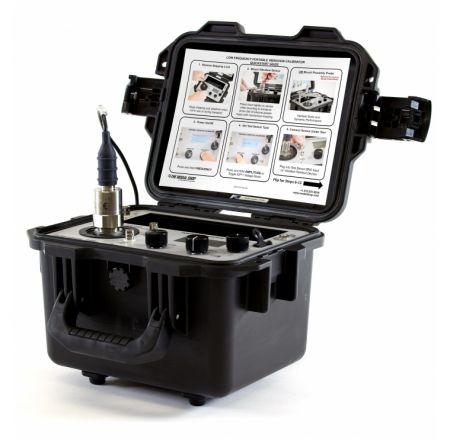
Features
- The best low frequency (slow speed) performance of any portable vibration calibrator
- Vibration sensitivity display provides instant pass/fail indication
- Up to 800 gram payload supports testing of heavy industrial sensors used in applications such as hydropower
- Optional Eddy current probe (proximity probe) mounting kit
- Acceleration, velocity and displacement scales in metric and English units
- ISO 17025 accredited, NIST traceable device
- Up to 14 hour battery life
- Pelican® Storm case, armature lock provide superior durability
- Closed loop control reduces calibration time
9210D Low Frequency Portable Vibration Calibrator
Reduce Perceived Risk by Providing Calibration Certificates
Reduce perceived risk in a hard insurance market using the world’s first and only Low Frequency Portable Vibration Calibrator, The Modal Shop’s Model 9210D. Follow recommended best practices set forth by insurance underwriters by calibrating vibration sensors used on critical slow speed equipment at actual machine running speeds. The 9210D allows plant managers to put ISO 17025 compliant vibration calibration certificates in the hands of their insurance risk engineer at the end of the plant tour, making it easier to obtain business interruption insurance while promoting a safe, technologically advanced working environment.
The 9210D’s rugged design and payload capability simulates vibration at speeds as low as 42 CPM (0.7 Hz)and supports the creation of ISO 17025 compliant calibration certificates for:
- Industrial and seismic accelerometers
- Eddy current probes (proximity probes)
- Moving coil vibration sensors
- High-temperature charge-mode vibration systems
The lightweight and portable design also supports in-situ verification of:
- 4-20 mA loop velocity vibration transmitters
- Condition monitoring system, PLC, DCS and SCADA system alarms
- Portable vibration meters and analyzers
ROI’s
- Reduced Business Interruption Insurance Risk. Calibration and confirmation of alarms in the vibration protection system are part of the recommended best practices issued by risk engineers representing the world’s primary insurance underwriters. Checks, certifications and audits of the condition monitoring system – like a well maintained fire protection system - make the plant more desirable in a potentially tough insurance market.
- Cost Savings. Save the maintenance budget, validate old sensors instead of throwing them away. With no moving parts, piezoelectric instrumentation and proximity probes can generate reliable output for years. Too often these sensors are deemed disposable, tossed away and replaced on an annual basis.
- Promote Safety. Catastrophic machinery failures have dangerous consequences. The vibration protection system is often the last line of defense. Simulating vibration faults and testing the system ensures your teammates are safe on the job.
- Reduce Downtime. Machinery failure without warning becomes a thing of the past with a field tested vibration protection system.
- Peace of Mind. When that $1 million asset begins to fail, will you get a critical text to your cell phone from the monitoring system? The calibrator is a low cost insurance policy against vibration protection system failure. Simulating vibration faults at various running speeds allows reliability managers to ensure they will.
- Improve Personnel Efficiency. Stop “chasing ghosts”. Checking nuisance vibration trips with a portable shaker table identifies cabling faults, scaling errors, programming errors and sensor sensitivity shift allowing analysts to focus the real goal: uptime.
- Strengthen departmental relationships & confidence. Often false vibration alarm trips are just as costly as late trips. Operations department scoffs as reliability struggles to explain the shutdown to management. Confidence in the system erodes quickly and costs time and money. Field verification promotes confidence and uncovers system errors.
The 9210D makes slow speed calibration simple, fast and easy. Up to 500 calibration records can be stored on the shaker’s internal memory. Data is exported via supplied USB flash memory drive. ISO 17025 compliant calibration certificates for both frequency response and linearity are then created with three clicks of the mouse thanks to supplied Microsoft Excel® calibration workbook. There is no software to install and there are no licenses to purchase.